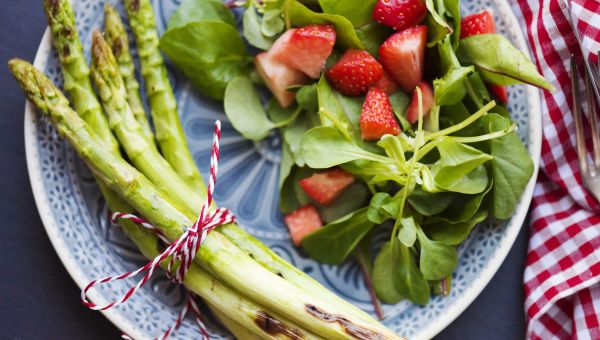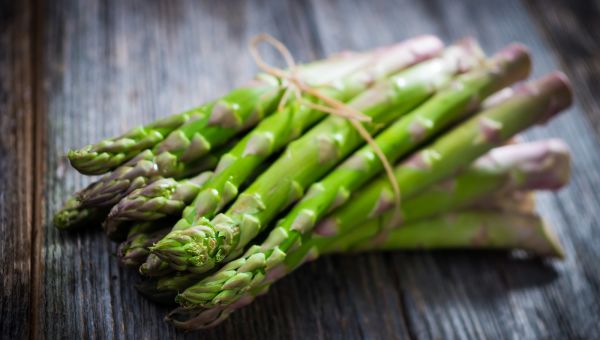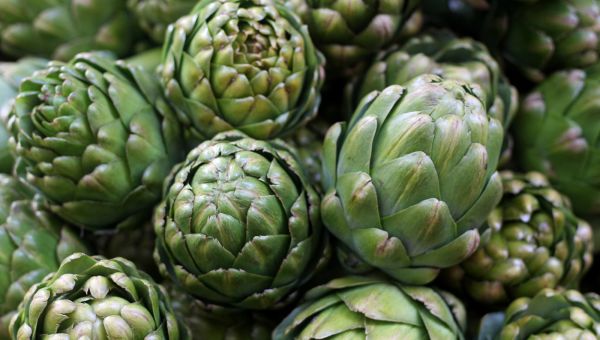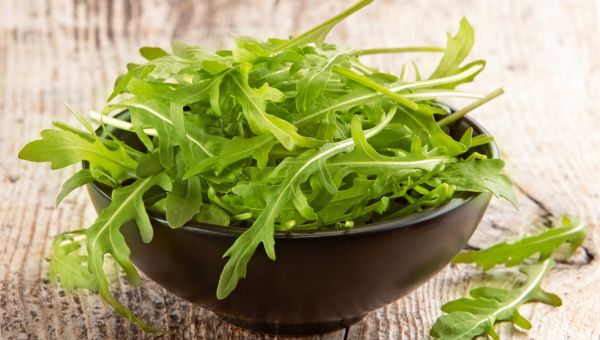Top 5 fruits and veggies for spring
Find out which seasonal fruits and vegetables need to be on your plate this spring.
Updated on September 15, 2023

The birds are chirping, the rain is falling, and the pollen count is through the roof. That can only mean one thing: Spring has sprung. And with the change in weather comes a new set of seasonal fruits and vegetables that not only taste delicious, but pack a serious nutritional punch. The next time you head to the grocery store or the farmers market, don’t forget to pick up these five spring treats.

Asparagus
In many areas across the United States, these delicate, nutrient-rich stalks are among the first spring vegetables ready to eat. That’s a good thing, because among numerous vitamins and minerals, asparagus is a good source of:
- Vitamin A, a powerful antioxidant—or compound that helps prevent cell damage—that helps keep the eyes, heart, lungs, kidneys, and other organs healthy
- Vitamin K, important for strong, healthy bones
- Thiamin, which helps maintain brain and liver function
- Iron, necessary for red blood cell formation, neurological development, and physical growth
It’s low in calories and carbs, too: 1 cup has only 27 calories, more than a quarter of which are from protein.
Need help adding asparagus into your diet? Enjoy it grilled, steamed, sautéed, or in Tomato Asparagus Salad.

Strawberries
Sweet, versatile, and widely available come spring, strawberries are a rich source of phenolic antioxidants, compounds that have been found to help lower cholesterol levels and can protect against heart disease, cancer, and diabetes. Strawberries are also loaded with potassium, fiber, and vitamin C, which promotes a healthy immune system. At just 72 calories per cup, they’re a wise choice to help manage weight, as well.
Strawberries can be enjoyed a number of ways—on their own, as part of a salad, or paired with chocolate to name just a few.

Artichokes
Looking for a healthy veggie that’s a little bit out of the ordinary? Serve up some artichokes this spring. Part of the thistle family, artichokes are low in calories and high in a carbohydrate called inulin, which may promote weight loss, decrease the risk of colon cancer, act as an anti-inflammatory agent, enhance mineral absorption, improve constipation, relieve depression symptoms, and improve blood sugar in people with diabetes. The inulin in artichokes may even help ease stomach problems like bloating and gassiness.
Artichokes are also high in an antioxidant called lutein, which may help prevent or slow the progression of macular degeneration, an eye disease that wears down your central vision.
Consuming artichokes involves some preparation, as they can’t be eaten raw. Try steaming, boiling, braising, or grilling them, taking care to chop off the tops and remove the pointy tips of their leaves. Artichokes can also be used in salads and as a key ingredient in a creamy dip.

Arugula
The next time you make a salad, give arugula a try. The peppery leafy green—technically a cruciferous vegetable like broccoli and cabbage—has 10 times the calcium, eight times the magnesium, and three times the phosphorus of iceberg lettuce.
Like other cruciferous veggies, arugula also contains glucosinolates, plant chemicals that lab studies suggest may fight cancer. In a 2018 meta-analysis published in Molecular Nutrition & Food Research, for example, eating cruciferous veggies were associated with lower lung cancer risk.
Arugula is among the easiest, speediest greens to grow on your own. Whether you harvest it from your yard or buy a bunch from the grocery store, try it in a salad, tossed with olive oil and lemon, or piled on top of pasta or pizza.

Beets
You may believe that since beets are a root vegetable, they’re exclusive to autumn. But these versatile staples are available across the U.S. throughout the year, and in many places—especially warmer areas—are considered to be in-season during spring.
Beets are nutritional powerhouses, full of antioxidants and high in both folate and fiber. The fiber can improve bowel function and cholesterol, while the folate promotes cell growth and the production of red blood cells. Beets and beet juice can also boost heart health by helping to lower blood pressure, among other benefits.
Beets can be juiced, sautéed, baked, dried, or roasted with olive oil and your favorite herbs and seasoning. With a little preparation, they can be eaten raw, too, such as on a salad. Beet greens are edible, as well, and are good sources of vitamins, minerals, and fiber.

Academy of Nutrition and Dietetics. Make a Fresh Start with Spring Foods. April 26, 2022.
National Institutes of Health. Vitamin A and Carotenoids. June 15, 2022.
National Institutes of Health. Iron. April 5, 2022.
MedlinePlus. Antioxidants. Last updated December 26, 2017.
Zeb A. Concept, mechanism, and applications of phenolic antioxidants in foods. J Food Biochem. 2020;44(9):e13394.
National Institutes of Health. Vitamin C. March 22, 2021.
Wider B, Pittler MH, et al. Artichoke leaf extract for treating hypercholesterolaemia. Cochrane Database Syst Rev. 2013;(3):CD003335.
Qin YQ, Wang LY, et al. Inulin: properties and health benefits. Food Funct. 2023;14(7):2948-2968.
FoodInsight.org. What is Lutein? December 18, 2018.
Johns Hopkins Medicine. Age-Related Macular Degeneration (AMD). Accessed September 15, 2023.
Sturm C, Wagner AE. Brassica-Derived Plant Bioactives as Modulators of Chemopreventive and Inflammatory Signaling Pathways. Int J Mol Sci. 2017;18(9):1890.
Zhang Z, Bergan R, et al. The Role of Cruciferous Vegetables and Isothiocyanates for Lung Cancer Prevention: Current Status, Challenges, and Future Research Directions. Mol Nutr Food Res. 2018;62(18):e1700936.
American Heart Association. Give me a beet: Why this root vegetable should be on your plate. February 22, 2023.
More On


video

article

slideshow


video


video
